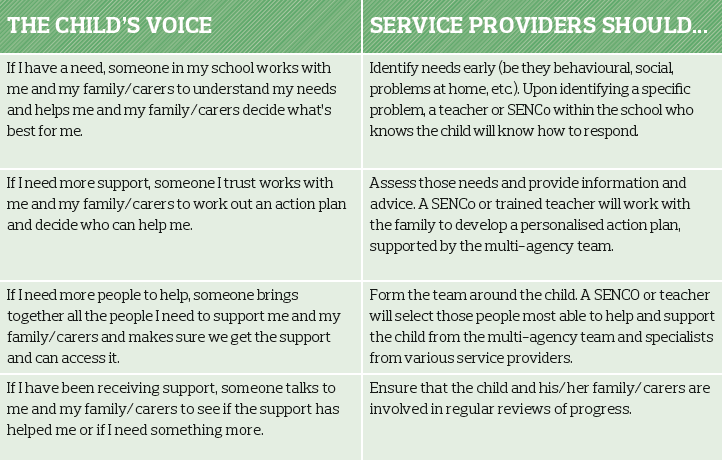What Should Schools do when LA Services Disappear?

With local authority services continuing to be scaled back, Professor Sonia Blandford looks at how schools can plug the gap by liaising with external agencies…

- by Teachwire
- Classroom expertise and free resources for teachers

Funding for SEND is going through challenging times. Services once provided by local authorities are being scaled back, and in some areas the role of ‘Area SENCo’ within the local authority is becoming less clearly defined. LA advice, previously just an email or phone call away, is now harder to find.
The Children and Families Act (2014), legislated for a more inclusive approach in educational settings for children and young people with special educational needs and disabilities.
The current SEND Code of Practice makes clear that it is mandatory for schools to appoint a SENCo with certain defined responsibilities, but they are currently having to do so within a difficult economic climate.
New ways of working
The situation could be worse, however. In schools, SEND has come quite a long way in a relatively short period of time. There is now greater clarity around identification and support, and more importantly, higher expectations for children and young people with SEND.
Now is the time for schools to take a lead by auditing their SEND provision, scrutinising their internal systems and developing effective channels of communication with external agencies.
Effective partnership working is at the centre of the government’s programme for creating a better system for children and their families, with the aim of improving long term outcomes.
The Children and Families Act confers a duty on LAs that should bring about better integration of education, health and social care provision, where this will promote wellbeing and improve the quality of provision for those with SEND.
These reforms are far-reaching, with many entailing a change in culture, perception and the professional experience among teachers and other school professionals.
Improving outcomes for children will increasingly depend on the integrated working of multi-agency teams in which effective communication between managers, headteachers and SENCOs will be essential.
It’s important that there’s a clear understanding as to what is intended – a change in the way that schools both see themselves and are seen within the community.
This follows a recognition by the government that environment and circumstances can have a significant impact on a child’s learning, attainment and future life chances, and that engaging parents, carers and other related agencies will have a positive impact on children’s achievement.
A family-centred focus
This family-centred focus of the government’s change programme is not concerned with the provision of services per se, but with providing services that meet the needs of the child and improve their outcomes in a person-centred approach.
Successful practice in a multi-agency and multi-disciplinary context means being clear about your role and aware – and respectful of – the roles of other workers and agencies.
You should actively seek out and respect other people’s knowledge and input, and use that to deliver the best possible outcomes for children and young people.
To ensure every child and his or her family has someone who knows them, and with whom they can talk, educational settings must develop policies and protocols that will facilitate seamless service.
This table (adapted from the government-produced document Building Brighter Futures) still provides a good framework for guiding initial practice and highlighting where schools might need to take further action.
Three principal models
All agencies have to recognise the importance of involving children and parents or carers. The consultative responsibilities and communication systems at school level will also need to be clearly identified.
Organisational structures and working practices must reflect this principle, so that joint planning arrangements do the following:
- Take account of good practice
- Ensure consultation with all relevant services
- Involve agreed priorities
- Clearly communicate decisions to parents, carers and professionals
- Review policies and objectives
In practice, there are three principal models of multiagency working with which you might be involved.
The first is the ‘multi-agency panel’, whereby members remain with their agency, but meet regularly to discuss children with additional needs who would benefit from multi-agency input. Panel members may carry out case work or take on a more strategic role.
The second, ‘multi-agency teams’, see members seconded or recruited onto a team with a leader and common purpose and goals. They may still receive supervision and training from their home agency, but have the opportunity to work with a range of different services.
In the final model, ‘integrated services’, different services (such as ‘health’ and ‘education’, for example) are co-located to form a highly visible hub within the local community. Funded by the partner organisations and managed to ensure integrated working, they will often be based in schools or early years settings.
Examine your procedures
A key concern for schools today should be to ensure that their SENCo is an active member of a local Network Group. After this, consider whether the leadership of SEND across your school might involve a culture change and examine your procedures for internal communication – particularly between managers, headteachers and SENCOs.
Look also at your external communications procedures and the extent to which teachers must take on responsibility for those with SEND, rather that relying on the SENCo alone.
Most importantly of all, consider this – are you listening to the voices of the parents, carers and children?
Sonia Blandford is the founder and CEO of Achievement for All, a provider of education programmes to early years settings, schools and FE colleges; for more information, visit afaeducation.org.











